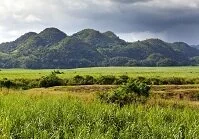Weather

Nassau Mountains
Temperatures in Jamaica make few variations from season to season. At lower elevations temperatures average 75-85° F (24-29° C) year round, while at elevation these temperatures are a bit cooler at about 60-72° F (15-22° C) year round. Rain arrives year round in Jamaica, but is heaviest from May to October, most particularly in the northern and eastern parts of the island. Jamaica also falls in the hurricane zone of the Caribbean Sea and is regularly hit with hurricanes from June to November.
Wildlife
Jamaica has an odd wildlife system as the island nation has few indigenous mammals due to its volcanic origin; the hutia (also called the coney), a rodent is about the only native mammals although there are also other mammals that have been introduced, including the now common mongoose. Plus, off the island's shore are more mammals and great sea life such as whales, dolphins, and manatees. In addition to these animals, as an island nation there are thousands of fish surrounding the country and these waters contain larger animals like sharks, but also include eels, angelfish, barracudas, grouper, sponges, lobsters, snapper, crabs, and thousands more including coral.
Like the sea life, there are plenty of birds that live on the island or migrate through. These birds tend to be divided into water fowl and woodland birds and they include hummingbirds, parrots, pelicans, and owls among others. The reptilian and amphibian life is also limited in scope, but there are crocodiles, turtles, lizards, snakes, iguanas, and frogs among others. There are numerous other species, including insects, most notably butterflies on the island.